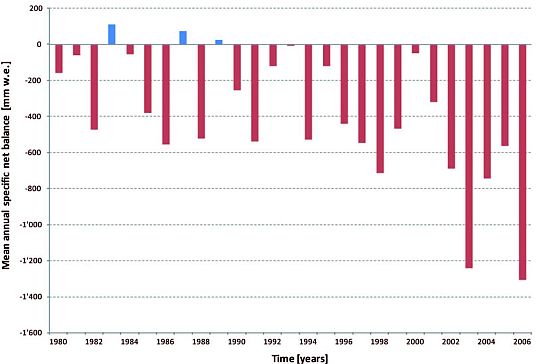“Record Glacier Thinning Means No Time to Waste on Agreeing New International Climate Regime,” said the U.N. Environment Programme on Sunday.
That statement is based on the data of the World Glacier Monitoring Service, which “has been tracking the fate of glaciers for over a century. Continuous data series of annual mass balance, expressed as thickness change, are available for 30 reference glaciers since 1980.” Here’s the mean annual specific net balance:

The Service calculates thickening and thinning of glaciers in terms of “water equivalent.” The estimates for the year 2006 indicate that further shrinking took place equal to around 1.4 metres [1400 mm] of water equivalent compared to losses of half a metre in 2005.
Prof. Dr. Wilfried Haeberli, Director of the Service, said:
The latest figures are part of what appears to be an accelerating trend with no apparent end in sight … This continues the trend in accelerated ice loss during the past two and a half decades.
I know what you’re thinking: “Trend? No end in sight? But Dr. Haeberli, everybody knows the globe is cooling, and the apparent warming is just the urban heat island effect plus lousy temperature-recording stations.” As Dr. Haeberli might reply, if he had Jon Stewart’s sensibility, “Damn you, 30 reference glaciers!”
Why should we care about a bunch of melting glaciers?
Achim Steiner, UN Under-Secretary General and Executive Director of UNEP (which funds WGMS) explains:
Millions if not billions of people depend directly or indirectly on these natural water storage facilities for drinking water, agriculture, industry and power generation during key parts of the year. There are many canaries emerging in the climate change coal mine. The glaciers are perhaps among those making the most noise and it is absolutely essential that everyone sits up and takes notice …
The litmus test will come in late 2009 at the climate convention meeting in Copenhagen. Here governments must agree on a decisive new emissions reduction and adaptation-focused regime. Otherwise … like the glaciers, our room for manoeuvre and the opportunity to act may simply melt away.
Is he comparing us to glaciers? How could we be anything like huge blocks of ice that move really, really, really slowly?
This post was created for ClimateProgress.org, a project of the Center for American Progress Action Fund.


